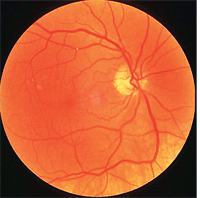How many times have you changed somebody’s life? Some may say that taking a 6.00D teenager from glasses to contacts can change a life—and I would agree. But I’m talking about empowering patients with the tools needed to change the way they see, feel, think, breathe and sleep. In other words, change the way they live.
Most of us are not comfortable discussing lifestyle choices with our patients. You may say, “I’m their eye doctor, I want to know which is better—one or two—not what they had to eat for breakfast this morning!” The inherent problem with that mentality is that our patients trust the medical establishment to keep them healthy. But, general practitioners simply don’t have the time to discuss the importance of healthy choices with their patients, so they often prescribe medications instead of taking a few minutes to go over some easy-to-implement changes they can make.

A slit lamp photograph of a patient with cataracts. Oxidative toxins found in cigarette smoke are a likely cause of cataract formation in smokers. Courtesy Elizabeth Hoppe, O.D.
Our patients know it is not healthy to smoke. But what they don’t know is that smoking is consistently associated with nuclear cataracts. The estimated increased risk of nuclear cataract to smokers is approximately 9% for every 10 pack-years smoked.1 Maybe our patients will smoke less per day, or even quit completely, once they learn that their eyes (not just their lungs) are at increased risk.
A study published in the Journal of the American Dietetic Association found that a substantial portion of people over 50 do not get enough vitamins and minerals from their diet alone, and the use of supplements is necessary.2 So let your patients know that they can reduce their risk of cataracts by simply taking a multivitamin.3
As health care providers, O.D.s have an opportunity to make a big impact on our patients’ lives. We must remember that what’s good for the heart is good for the eyes and that eating right, exercising regularly and taking a decent multivitamin is the least we can do to defend ourselves against the stresses (mental, physical and oxidative) of life.
I was out to dinner with some friends when one of them ordered a 32oz. porterhouse steak. His wife asked him to consider something healthier because he was recovering from heart surgery performed just weeks before. He told her not to worry, “I can eat what I want! I’ll just take an extra Lipitor tonight before bed.” What’s wrong with this picture?
The Pitfalls of the American Lifestyle
I’ll go out on a limb and make the correlation between our national health care crisis and the average American’s lifestyle. By age 50, the average American is taking prescription medications, exercising less than two hours a week and considers dipping French fries into ketchup two servings of fruits and vegetables. It seems that these days, a healthy lifestyle choice has come down to making the decision not to supersize a fast food meal.
If Americans made healthy lifestyle choices more often, the financial burden on future generations would be decreased. If more people ate well and exercised, they wouldn’t need as many examinations, scans, surgeries or follow-up care.
The nutritional value of our food is being depleted by preservatives, herbicides, pesticides, shipping, spraying and storing. Think about how little the human body has evolved over the past 50, 100, 500 years. Now think about the human diet’s evolution over the same time span. Our ancestors did not prepare oatmeal in 30 seconds or even five minutes. It takes 45 minutes to prepare nutritious oatmeal.4 How many of us—doctors or patients—take the time out of our busy morning to do that? Because of our fast-paced lives, we are absorbing less and less nutrients from our food.
The sedentary lifestyles that most of us have embraced are also a problem. We are designed to be hunters and gatherers, varying our eyes’ focus and body position frequently, rather than sitting in one spot and staring at a monitor for hours each day. The only position change many of us experience is from sitting up to lying down. We don’t need to leave our cozy environment anymore. We can call, text, fax, e-mail or surf the net to the point of extreme isolation.
Promote Healthy Choices in Your Office

Obstruction of retinal blood vessels in a patient with elevated cholesterol levels.
The topic of healthy lifestyle choices doesn’t start in the exam room—it starts in the waiting room. You can increase awareness by placing books, pictures, magazines, newsletters, brochures and even sample bottles of nutritional supplements in your waiting room.
This message should flow throughout the entire office. Think of your exam room as a stage: You can set the stage by having framed artwork depicting a healthy scene or personal pictures of athletic events scattered on the walls. I have a chakra scroll that hangs next to my Snellen chart (they all have to look there sooner or later). This way, I ensure a conversation about the healing benefits of yoga and deep breathing exercises. Personalize your office to depict the healthy lifestyle changes you’ve implemented.
An alternative to a static poster or picture frame is a digital photo frame displaying a slide show of photos and messages. In my experience, many conversations start with the spouse or whoever accompanies the patient in the exam room.
Many of us have patients we trust who are personal trainers, massage therapists, acupuncturists, yoga masters or nutritionists. Next time they come in for an exam, ask them for a few business cards and hand them out to other patients when you feel the need arises. There’s nothing wrong with increasing your cross referral base with other disciplines.
Establish an Open Dialogue
The history-taking phase of the exam is the perfect time to introduce lifestyle changes. A thorough history that includes current medications will help you learn about patients’ lifestyle choices, their general health and more importantly, the level of their self-interest.
When talking about systemic medications, put your pen down, look the patient directly in the eyes and ask, “What lifestyle changes did your doctor recommend prior to initializing prescription drug therapy for this condition?” After listening to the reply, follow up with “What lifestyle changes, if any, have you heard are beneficial for this condition (including vitamins and supplements)?”
This plants the seed that there are other sources of healthful information besides their medical doctor. Then ask, “Which vitamins and supplements do you currently take?” Proper phrasing is key. Notice the question wasn’t, “Are you taking any vitamins or supplements?”
Your next prompt should be, “How many hours a week do you exercise?” By posing this question, you alter the patient’s idea of a normal, healthy life. When they know that you are concerned about their lifestyle choices, they are more likely to discuss day-to-day changes.
It’s about here when most patients will say to you, “Hey doc, what does this have to do with my eyes?” To answer this question, tell your patients that what’s good for the heart is good for the eyes and that the opposite is also true. Cardiovascular diseases like hypertension, diabetes and heart disease can steal their vision.
What is the Metabolic Syndrome?

When discussing lifestyle changes, recommendations should include steps patients can take to ensure they are receiving adequate nutrition for ocular and systemic health.
A huge national health care concern is the increase in metabolic syndrome, especially in the adolescent population.5 The metabolic syndrome has become increasingly common in the
U.S. It’s estimated that over 50 million Americans have it.6
The metabolic syndrome is characterized by a group of metabolic risk factors, which include:
• Abdominal obesity.
• Atherogenic dyslipidemia (blood fat disorders, such as high triglycerides, low HDL cholesterol and high LDL cholesterol, that foster plaque buildups in artery walls).
• Elevated blood pressure.
• Insulin resistance or glucose intolerance (the body can’t properly use insulin or blood sugar).
• Prothrombotic state (e.g., high fibrinogen or plasminogen activator inhibitor–1 in the blood).
• Proinflammatory state (e.g., elevated C-reactive protein in the blood).
A recent increase in metabolic syndrome rates could translate into a health care cost nightmare. By educating our patients on risk reduction through lifestyle changes, we, along with our patients become part of the solution.
People with the metabolic syndrome are at increased risk of type 2 diabetes, coronary heart disease and other diseases related to plaque buildups in artery walls (e.g., stroke and peripheral vascular disease).
For managing both long- and short-term risk, lifestyle therapies are the first-line interventions to reduce the metabolic risk factors. These lifestyle interventions include:6
• Weight loss to achieve a desirable weight (BMI less than 25 kg/m2).
• Increased physical activity, with a goal of at least 30 minutes of moderate-intensity activity on most days of the week.
• Healthy eating habits that include reduced intake of saturated fat, trans fat and cholesterol.
The Need to Supplement
You can’t pick up a journal or go to a major continuing education event without seeing or hearing about vitamins and how they help protect the eye from “oxidative damage.”
While attending a regional board of directors meeting (18 local society Presidents and Vice Presidents meeting with the Florida Optometric Association Board of Directors and their attorney) in Tampa, Florida, the following question was posed to the legal counsel: “Are optometrists who advise and dispense vitamins and supplements out of their office putting themselves at a greater risk for lawsuits?”
The attorney had a very clear answer. “All the studies proving the beneficial effects of vitamins and supplements on the overall health of the eye put us in a legal atmosphere where the optometrists who don’t recommend them to their patients are at greater risk.”7
Researchers found that a substantial portion of people over 50 years of age do not get enough vitamins and minerals from their diet alone, and the use of supplements is necessary.8
Many people are eating a majority of their food outside their home, so they have even less control over the nutritional value of their daily intake. A highly absorbable multivitamin is a good insurance policy for these deficiencies.
Many factors can be blamed for the reduced absorption of nutrients: poor diet, sedentary lifestyle, erratic sleep pattern, stress, prescription medications—the list of factors is endless.
There’s only one difference between prescription medications and poison—dosage. Most major classes of medications deplete our bodies of essential nutrients.9 Our patients come to us for many things, one of them being our advice on how they can stay healthy.
Americans take supplements on a daily basis, but the majority does so without medical advice. Many optometrists are business owners and all business owners look for ways to increase the bottom line. By promoting and selling vitamins and supplements, we not only can increase our bottom line, but also help our patients live a better, healthier life.
Who Will Reach Your Patients?
We used to glean knowledge from real life sources, like doctors who reference scientific data. But nowadays, we listen to someone else’s opinion on an event or product instead of forming our own after receiving the information from a reputable source. The old fashioned way just doesn’t sell.
Television reaches more people each day than any other medium, in almost every major demographic market segment.10 By age 65, the average person will have seen about two million advertisements on television, of which a large proportion will be for food.11 In 2004, annual expenditures on food-related advertisements totaled $11.26 billion, while the U.S.
Department of Agriculture spent a mere 2% of that amount ($268 million) on all nutrition education.12,13
In order to instill confidence in your knowledge of lifestyle changes, I recommend attending continuing education seminars on the subject. With a plethora of journal articles and recent studies proving the benefits of certain supplements for ocular health, your conversation and recommendations will only be reinforcing what your patient heard on the Today Show or Oprah the week before their exam.
Strategies for Success
We know that compliance is an issue with many patients. We ask our patients to dispose of their contact lenses in two weeks, but they consider four to six weeks reasonable. We ask them to use the eye drops four times a day, but they use them four times a week and complain about their symptoms. What I have implemented in my practice over the years is the use of analogies to reinforce my healthy advice. My family and staff commonly refer to them as “Newmanalogies.”
For my patients who are sleeping in their contact lenses, I ask them how many days they sleep in the same pair of underwear, pointing out that underwear and contact lenses both come into contact with bodily fluids. This allows them to think about their habits differently. Analogies such as this empower them to make the right choices and feel good about them.
Patients will be more compliant with our recommendations if they understand why we are asking them to implement our treatment plan. If you tell a dry eye patient suffering from epiphora to use artificial tears four times a day (something we commonly do), without explaining why it’s necessary, this patient walks out saying to themselves, “What a quack. I complain of wet eyes and he has the nerve to tell me that I have dry eyes and wants me to make them even wetter?”
If you follow your recommendation with an analogy, the chances of that patient complying with your treatment plan improve. You could say, “Your eyes are dry. They are asking your tear glands to help by producing more tears. But, because your eyes are so dry, these tears are not being absorbed; instead they are rolling off your eyes like rain drops on a freshly waxed car. This is why your tears run down your cheeks when you read. If you use the artificial tears four times a day, the signal to over-produce will not be turned on, resulting in no more tears running down your cheeks.”
With understanding comes compliance. With analogies, understanding comes more quickly. With an open dialogue between doctor and patient and the use of conversational analogies, we can achieve long-term compliance.
Set an Example
Nobody takes advice from a pulmonologist who smokes. Walk the walk if you are going to talk the talk.
Take a multivitamin of your choosing. Various reputable companies will deliver your own personal supply to your home or office. Take them, and you’ll feel the difference. In my case,
I’ve been taking the same multivitamin for the past 10 years, and I don’t feel any different. I still feel like I did when I was 18. That tells me they’re working just fine.
The key to successfully implementing lifestyle changes is moderation. Deprivation leads to failure, but limitation leads to success. We all have our comfort foods and routines. To ask patients to deny themselves these things is unrealistic. However, educating them on the health benefits of nutrition and exercise ensures ocular and systemic health and leads to a stronger doctor-patient relationship.
Dr. Newman is a motivational speaker and the author of “Feel More Alive Now,” a lifestyle book (BookSurge) Publishing. He practices nutritional optometry in Miami and Ft. Lauderdale and is a Board Certified Nutrition Specialist and Lifestyle Coach.
1. Klein BE, Knudtson MD, Lee KE, et al. Supplements and age-related eye conditions the beaver dam eye study. Ophthalmology. 2008 Jul;115(7):1203-8.
2. Sebastian RS, Cleveland LE, Goldman JD, Moshfegh AJ. Older adults who use vitamin/mineral supplements differ from nonusers in nutrient intake adequacy and dietary attitudes. J Am Diet Assoc. 2007 Aug;107(8):1322-32.
3. Maraini G, Sperduto RD, Ferris F, et al. A randomized, double-masked, placebo-controlled clinical trial of multivitamin supplementation for age-related lens opacities. Clinical trial of nutritional supplements and age-related cataract report no. 3. Ophthalmology. 2008 Apr;115(4):599-607.e1.
4. Maras JE, Newby PK, Bakun PJ, et al. Whole grain intake: The Baltimore Longitudinal Study of Aging. J Food Compost Anal. 2009 Feb 1;22(1):53-8.
5. Wardle J, Robb KA, Johnson F, et al. Socioeconomic Variation in Attitudes to Eating and Weight in Female Adolescents. Health Psychol. 2004 May;23(3):275-82.
6. Maury E, Ramsey KM, Bass J. Circadian rhythms and metabolic syndrome: from experimental genetics to human disease. Circ Res. 2010 Feb 19;106(3):447-62.
7. Personal communication. Leonard Carlson, attorney for the FOA.
8. Tripp F. The use of dietary supplements in the elderly: current issues and recommendations. J Am Diet Assoc. 1997 Oct;97(10 Suppl 2):S181-3.
9. Fennell D. Determinants of supplement usage. Prev Med. 2004 Nov;39(5):932-9.
10. Mink M, Evans A, Moore CG, et al. Nutritional imbalance endorsed by televised food advertisements. J Am Diet Assoc. 2010 Jun;110(6):904-10.
11. Herr N. Television Statistics. The Sourcebook for Teaching Science. Available at: www.csun.edu/science/health/docs/tv&health.html. (Accessed January 2011).
12. California Pan-Ethnic Health Network and Consumers Union. Out of balance: Marketing soda, candy, snacks and fast foods drowns out healthful messages. Available at:
www.consumersunion.org/pdf/OutofBalance.pdf. (Accessed January 2011).
13. Frost A, Walker K. Food Stamp Nutrition Education: Promoting Healthy Eating and Active Lifestyles. Available at:
www.nal.usda.gov/foodstamp/Training/October.ppt. (Accessed January 2011).

